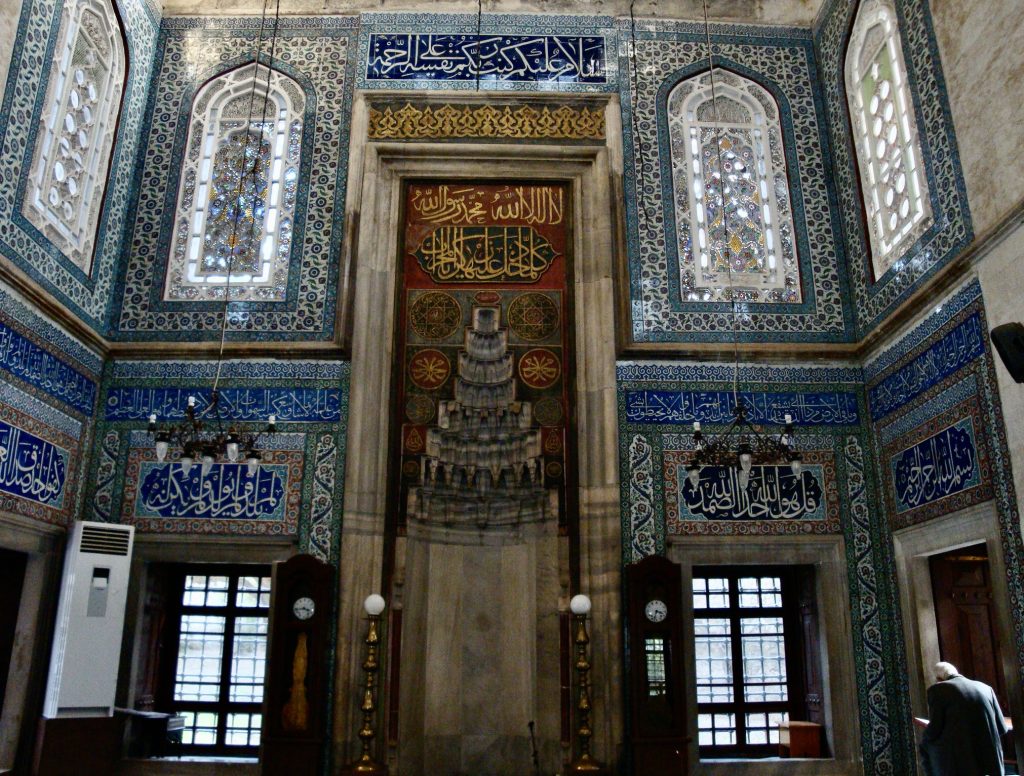City of the Princes Population: 385,500
Old name: Magnesia ad Sipylum
Festival: Manisa Mesir Macunu Festivali, third week in April
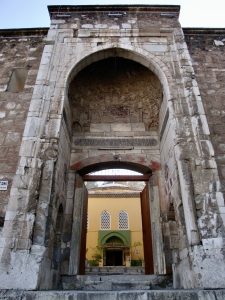
Manisa, near İzmir, is a city haunted by an absence. Nicknamed the City of the Princes (Şehzadeler Kenti), it was, like Amasya in northern Anatolia and Trabzon on the Black Sea coast, a town to which early Ottoman princes were despatched to cut their teeth as provincial governors. Of course young men who expected to become sultans would also have expected to live here in considerable comfort. Where, then, is the palace from which they would have conducted their business?
The answer is simple. It has vanished even more completely than the Eski Saray (Old Palace) in Edirne where a few battered walls still bear witness to a more glorious past. But of Manisa’s Saray-ı Amire, built in 1466 by Murad II and then expanded by Mehmed II, only fragments of the Fatih Kulesi (Conquest Tower) survived a disastrous fire (it has now being restored). Instead visitors to the town have to make do with a model based on an 18th-century miniature that has been set up in Mustafa Kemal Paşa Caddesi.
Here they will see a walled compound divided into two main sections and with a tower over the gate leading into the inner courtyard. Alongside the rooms for the princes and their mothers, the compound boasted numerous offices, stables and kitchens. It was a mini Topkapı Palace and we can only lament its loss.
In lieu of a palace Manisa has a superfluity of mosques, some of them dating back to early Ottoman days but some of them built in the preceding period when the town had served as the capital of the Saruhan Beylik, one of the mini kingdoms that sprang up all over Anatolia after the collapse of the Selçuk state.
The Saruhan Beylik was founded by the eponymous Saruhan who seized Manisa from the Byzantines in 1313 supposedly by driving a flock of goats with candles attached to their horns ahead of his army thereby fooling the enemy into thinking it much larger than it really was. Saruhan was buried in a tomb at the foot of Spil Dağı (Mt Spil, 1517m) that can still be visited today.
Don’t leave town without trying: Delicious Manisa kebab, thin, rather oily meatballs on a bed of pide.
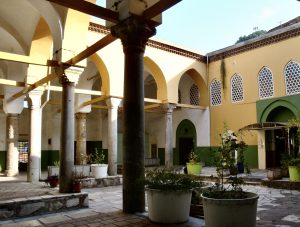
Around town
Start exploring on the hillside behind a statue of Merkez Efendi and his pot of healing ointment that sits in the middle of a traffic roundabout. On the hill behind it is the tomb of Saruhan.
Steps up the hillside behind the tomb lead to the first of Manisa’s real gems, the spectacular Ulu Cami (Great Mosque), built in 1366 by Saruhan’s grandson, İshak Çelebi, on the site of a Byzantine church. The courtyard of this mosque is filled with columns whose capitals were shamelessly filched either from the church or from monuments of Magnesia ad Sipylum, the city originally founded here by settlers from the Greek city of Magnesia as they headed home after the Trojan War.
As if that were not reason enough to visit the mosque, the mimber (pulpit) inside is a magnificent example of carved woodwork, and there are traces of delicate paintings on the walls and dome of the shrine to İshak Çelebi next door.
On leaving the mosque you will be faced with a choice. Those with bags of stamina will want to continue climbing up the hill to inspect the Sandıkkale (Dowrybox Castle) from which the Byzantine army was ejected. The view back over the town is certainly worth it. Those with less energy will probably prefer to settle down in the lovely tea garden in front of the mosque and soak up the panorama of Manisa below.
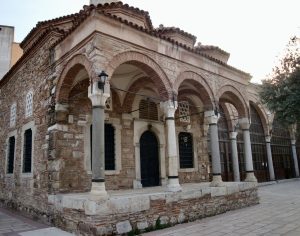 In the town centre there are four other especially impressive mosques, the oldest of them the Çeşnigir Cami, built in 1474 with a delightful little domed library attached to it; from its design and stonework you could be forgiven for assuming that it was contemporary with the mosque when in fact it was actually added on in the 19th century.
In the town centre there are four other especially impressive mosques, the oldest of them the Çeşnigir Cami, built in 1474 with a delightful little domed library attached to it; from its design and stonework you could be forgiven for assuming that it was contemporary with the mosque when in fact it was actually added on in the 19th century.
The Çeşniger is very close to the larger and more prominent Hatuniye Cami built in 1491 by Hüşnüşah Hatun, the mother of Şehzade (Prince) Şehinşah, during the years that her son was learning the governmental ropes. Rather heavy-handed restoration can’t detract from the finely carved design of the minaret, although one could certainly wish that the Byzantine capitals reused in the portico had not been painted over. Inside, the mimber is another magnificent example of wood-carving if not quite up to the quality of the one gracing the Ulu Cami.
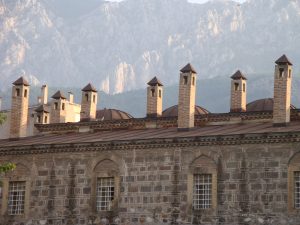 Right beside the mosque a small domed structure built some time after 1497 housed a sibyan mektep, or primary school. Nearby the restored Kurşunlu Han (Leaded Han) originally formed part of the mosque complex. Today it provides student accommodation in the rooms once used by travelling salesmen.
Right beside the mosque a small domed structure built some time after 1497 housed a sibyan mektep, or primary school. Nearby the restored Kurşunlu Han (Leaded Han) originally formed part of the mosque complex. Today it provides student accommodation in the rooms once used by travelling salesmen.
On arrival in Manisa you will probably have formed the impression that it’s a wholly modern town, well-ordered, but made up mainly of the usual concrete canyons of high-rise buildings. This modernity is partly the result of damage done to the city during the 1919-22 Turkish War of Independence, when the last battered remains of the Saray–ı Amire, abandoned at the end of the 16th century, seem to have burnt down. But the area around the Çeşniger and Hatuniye mosques feels much more like a traditional Anatolian town, its bazaar of tiny shops shaded by colourful Virginia creeper.
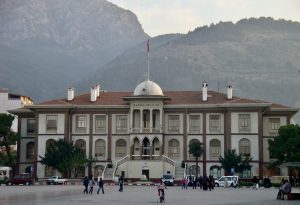 Here, too, you’ll find a few fine 19th and 20th-century buildings, including the striking Hükümet Könağı (Government Building), erected in 1908, destroyed in the fighting of 1922, then rebuilt again in 1925, as well as the Yeni Han (New Han), another building that looks much older than its seeming 19th-century date that has been restored to house a mixture of cafes and craftshops.
Here, too, you’ll find a few fine 19th and 20th-century buildings, including the striking Hükümet Könağı (Government Building), erected in 1908, destroyed in the fighting of 1922, then rebuilt again in 1925, as well as the Yeni Han (New Han), another building that looks much older than its seeming 19th-century date that has been restored to house a mixture of cafes and craftshops.
Manisa still has two more fine early Ottoman mosques up its sleeve. The first is the Sultan (Mesir) Cami, built by Hafza Sultan, the mother of Süleyman the Magnificent, in 1539 and approached via a portico whose vaults are covered with vivid baroque paintings. Of the complex attached to the mosque, the double hamam is still in the bathing business while the bimarhane, or mental hospital, is now a small medical museum. The Taş Mektep (Stone Primary School) houses a rather nice cafe where you can sip blue tea (yes, really) while admiring a collection of photographs of the Manisa of the 19th century.
The small park behind the mosque boasts a bust of Hafza Sultan who fell ill while staying in Manisa with her son. It seemed that nothing could save her. Then a local pharmacist called Merkez Efendi whipped up a concoction called mesir macunu consisting of 41 different ingredients, the sultana made a miraculous recovery and the rest is the history of a festival that still takes place every spring during which the paste is tossed from the minaret to the awaiting crowd who swear by it to cure all manner of ailments.
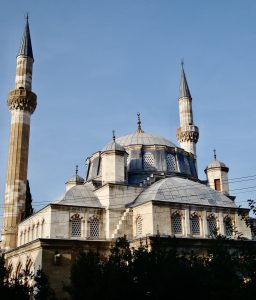 Of course a town so closely linked with the glory days of the Ottoman Empire could not be without a mosque by the great architect Sinan and so it is that the Muradiye Cami was at least designed by the master although it was brought to fruition after his death by Sedefkar Mehmed Ağa, the architect behind İstanbul’s Sultanahmet (Blue) Mosque.
Of course a town so closely linked with the glory days of the Ottoman Empire could not be without a mosque by the great architect Sinan and so it is that the Muradiye Cami was at least designed by the master although it was brought to fruition after his death by Sedefkar Mehmed Ağa, the architect behind İstanbul’s Sultanahmet (Blue) Mosque.
The mosque is an absolute treasure, built in a style that harps back to earlier models that tended to stretch out to the right and left rather than focusing on the centre in the familiar way of later mosques. An exquisitely carved and painted mihrab is set in a wall pierced by stained-glass windows and decorated with fine İznik tiles. It would be hard to imagine a more splendid building.
The Muradiye came complete with a complex, the medrese (theological school) and imaret (soup kitchen) of which now house Manisa’s museum (closed Mondays). In theory this is the place to come to admire the finds from nearby Lydian Sardis although for decades only the ethnographic section has been open to the public. For most people the extraordinary quality of the also-ran pieces of sculpture left outside in the grounds should go a long way to make up for the disappointment. Rumours that it would reopen (in a new building) in 2023 have not yet come to anything.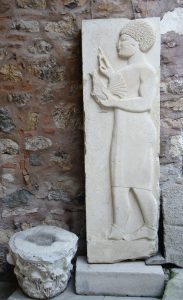
At the back of the town in the foothills of Spil Dağı is a rock formation (Ağlayan Kaya – Weeping Rock) rather fancifully said to represent Niobe, the Greek woman who had dared to boast that she had more children (14) than Leto (2) in punishment for which they were all killed by Apollo and Artemis.
Also in the foothills is a Mevlevihane that was once one of the largest in the country. Today it houses a fairly ordinary museum celebrating the whirling dervishes.
Eating and drinking
Manisa is hardly going to set the world alight when it comes to food but you can get a very good Manisa kebab in the Taşfabrika Cafe-Restaurant behind the Hükümet Konağı – it was created out of an old factory in 2014.
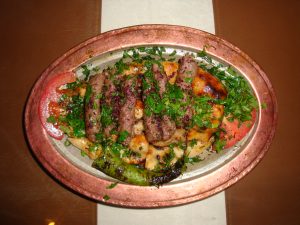 Cafe society is just starting to get into its stride beside the main square. Kahve Durağı is bound to be full of bright young things from Cemal Bayır University. A large branch of Kahve Sokaği has probably joined it by now.
Cafe society is just starting to get into its stride beside the main square. Kahve Durağı is bound to be full of bright young things from Cemal Bayır University. A large branch of Kahve Sokaği has probably joined it by now.
Sleeping
Manisa is easily visited on a day trip from İzmir.
Hotel Anemon. Tel: 0326-233 4141
Hotel Arma. Tel: 0326-231 1980
Hotel Büyük Saruhan. Tel: 0326-233 0272
Hotel Spilos. Tel: 0326-233 2565
Oreko Hotel. Tel: 0326-502 1111
Travel info
There are frequent buses to Manisa from the upper floor of İzmir bus station or you can catch a train from Basmane station.
Unfortunately Manisa now has a non-central otogar – you can get to it from the main square in front of the Hükümet Konağı using bus Hat 2 (Line 2). Usually you will still be able to pick up a bus back to İzmir from opposite the more central Eski Garaj (old bus station) but of course it could be full.
Returning to İzmir ask to be dropped near Evka-3 Metro station which will whisk you back to Basmane, Çankaya or Konak more quickly than if you travel via the bus station.
Day trip destinations
Manisa Mesir Macunu Festivali
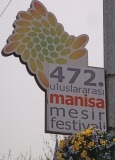 More than 480 years old, this festival used to take place in the days following the spring solstice with the main event, the tossing of mesir macunu from the domes of the Sultan Medrese happening after midday prayers on the Sunday after the solstice. However, it has now been moved to April when better weather is likely. It’s a popular event and big crowds gather so you need to arrive several hours early to be sure of a good place where you can watch the parade that precedes the mesir-macunu tossing and the tossing itself.
More than 480 years old, this festival used to take place in the days following the spring solstice with the main event, the tossing of mesir macunu from the domes of the Sultan Medrese happening after midday prayers on the Sunday after the solstice. However, it has now been moved to April when better weather is likely. It’s a popular event and big crowds gather so you need to arrive several hours early to be sure of a good place where you can watch the parade that precedes the mesir-macunu tossing and the tossing itself.
Read about my visit to Manisa: http://www.turkeyfromtheinside.com/index.php?option=com_easyblog&view=entry&id=29&Itemid=218
